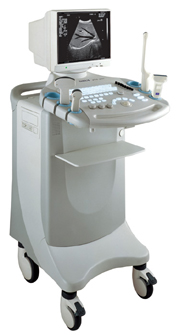Medical Ultrasound Imaging
Monday, 20 May 2024
'Rectal Probe' p4 Searchterm 'Rectal Probe' found in 23 articles 1 term [ • ] - 16 definitions [• ] - 6 booleans [• ]Result Pages : •
(TRUS) Transrectal sonography (also called transrectal ultrasonography, transrectal echography (TRE), endorectal ultrasound (ERUS or EUS)) is an ultrasound procedure used to examine the prostate gland, the rectum or bladder. A small, lubricated transducer placed into the rectum releases sound waves, which create echoes as they enter the region of interest. A computer creates a picture called a sonogram. TRUS is commonly used for guidance during a prostate needle biopsy and may be used to deliver brachytherapy and monitor cancer treatment. Transrectal ultrasonography detects enlargement, tumors and other abnormalities of the prostate, rectal polyps, rectal cancer, perianal infection, and sphincter muscle injuries. TRUS is also performed on male patients with infertility to view the prostate and surrounding structures and on patients with suspected bladder conditions or disease to view the bladder. See also Transurethral Sonography, Endoscopic Ultrasound, Pelvic Ultrasound, Rectal Probe, Biplane Probe, Endocavitary Echography and High Intensity Focused Ultrasound. Further Reading: News & More:
•
Transurethral echography or sonography is used to detect small tumors of the urinary bladder or to visualize the urethra and surrounding muscles with special transducers. The bladder neck can be visualized using a transrectal probe. In addition, high intensity focused ultrasound provides treatment of benign prostatic hyperplasia and adenocarcinoma of the prostate. Small catheter-based sectored tubular or planar transducers with highly directional energy deposition and rotational control are used for precise treatment. Regions of the prostate can be selective coagulatet while monitoring and controlling the treatment with MRI. See also Urologic Ultrasound, Lithotripsy, Reflux Sonography, Ultrasound Therapy, Interventional Ultrasound and Thermotherapy. Further Reading: News & More:
•  From SIUI Inc.;
From SIUI Inc.;'Dedicated to ultrasound industry, Shantou Institute of Ultrasonic Instruments, Inc. (SIUI) has launched Apogee 3500, the Digital Color Doppler Ultrasound Imaging System. With latest imaging technologies, high-definition image quality and excellent practical functions, the Apogee 3500 offers optimal solutions for clinical ultrasonic examination.' 'The Apogee 3500 is available with many high-density, super broadband and multi-frequency probes, such as convex, micro-convex, linear, vaginal, rectal and phased array probes, which are widely applied for different clinical diagnoses, including abdomen (liver, kidney, gall-bladder, pancreas), gynecology (uterus, ovary), obstetrics (early pregnancy, basic OB, complete OB, multi gestation, fetal echo), cardiology (adult and pediatric cardiology), small parts (thyroid, galactophore, testicles, neonate), peripheral vascular and prostate.'
Device Information and Specification
CONFIGURATION
Normal system, color - gray scale(256)
Linear, convex and phased array
PROBES STANDARD
2.0 MHz ~ 12.0 MHz, broad band, tri-frequency
B-mode (B, 2B, 4B), M-mode, B/M-mode, real-time compound imaging, panoramic imaging, trapezoidal imaging (linear probes), spectrum Doppler (PWD and CWD), color Doppler flow imaging (CDFI), color power angio (CPA), tissue harmonic imaging (THI)
IMAGING OPTIONS
Real-time ZOOM, zoom rate and position selectable
OPTIONAL PACKAGE
H*W*D m
1.29 * 0.52 * 0.75
WEIGHT
110 kg
POWER REQUIREMENT
AC 220V/110V, 50Hz/60Hz
POWER CONSUMPTION
0.6 KVA
•
(EUS) Endoscopic ultrasound uses a small probe that is inserted in the rectum either through a proctoscope or by itself. During the test biopsies of any suspicious areas are possible. The usual necessary preparation is an enema to empty the rectum. Endoscopic ultrasound provides additional information about rectal polyps, rectal cancer, perianal infection, and sphincter muscle injuries and improves the selection of patients for local excision. Transrectal echography using a high-frequency transducer is a well established method for preoperative rectal carcinoma assessment. Endoscopic scanning is limited by the ultrasound physics (depth and axial resolution) of the endocavitary probe. Therefore, the combination of endoscopic and transcutaneous ultrasound is most favorable. •
(HIFU / FUS) High intensity focused ultrasound is used in thermotherapy or thermoablation e.g., for the treatment of benign prostate hyperplasia or under study for the treatment of cancer. An applied ultrasound probe (see transrectal sonography) focuses sound waves at one spot, elevating the tissue temperature to a point that the tissue destroys. Generally, lower frequencies (from 250 kHz to 2000 kHz) are used than for medical diagnostic ultrasound, but significantly higher time-averaged intensities. See also Magnetic Resonance Guided Focused Ultrasound, Low Intensity Pulsed Ultrasound, and Lithotripsy. Further Reading: Basics: Result Pages : |
Medical-Ultrasound-Imaging.com
former US-TIP.com
Member of SoftWays' Medical Imaging Group - MR-TIP • Radiology TIP • Medical-Ultrasound-Imaging
Copyright © 2008 - 2024 SoftWays. All rights reserved.
Terms of Use | Privacy Policy | Advertise With Us
former US-TIP.com
Member of SoftWays' Medical Imaging Group - MR-TIP • Radiology TIP • Medical-Ultrasound-Imaging
Copyright © 2008 - 2024 SoftWays. All rights reserved.
Terms of Use | Privacy Policy | Advertise With Us
[last update: 2023-11-06 01:42:00]




